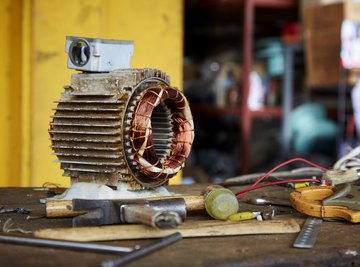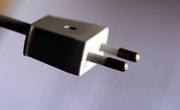
Nikola Tesla invented alternating current motors, or AC motors, in the late 19th century. AC motors are different from DC or direct current motors in their use of alternating current, which changes direction. AC motors transform electrical energy to mechanical energy. AC motors are still heavily used in modern life, and you may find them in appliances and gadgets in your own home.
TL;DR (Too Long; Didn't Read)
Alternating current motors or AC motors were invented by Nikola Tesla in the 19th century. AC motor theory entails the use of electromagnets with currents to create force, and therefore motion.
What Is the Principle of the Motor?
The simplest principle of the motor is to use electromagnets with currents to create force to move something – in other words, to convert electrical energy to rotational mechanical energy. Motors are set up with electromagnets in nested rings with the magnets' polarities alternating north to south in the rings. Rotor magnets move while stator magnets do not. The north-south polarity of these electromagnets has to reverse constantly.
How Does an AC Motor Work?
Prior to Tesla’s inventions, direct current motors were the presiding type of motor. An AC motor works by applying alternating current to stator windings, which produce a rotating magnetic field. Because the magnetic field rotates in this way, an AC motor does not need power or mechanical aid to be applied to the rotor. The rotor will rotate via the magnetic field and create torque on the drive shaft of the motor. The speed of rotation varies based on the number of magnetic poles in a stator. This speed is called synchronous speed. AC induction motors, however, operate with a lag or slip to allow the flow of rotor current.
Different AC motors will have different numbers of poles and therefore varying speeds in comparison with each other. The speed of an AC motor, however, is not variable itself, but rather constant. This is in contrast to many DC motors. AC motors do not require the brushes (power contacts) or commutators that DC motors need.
Tesla’s inventions vastly changed the landscape of motors, allowing more efficient, reliable devices. These AC motors revolutionized industries and paved the way for uses in many appliances used in the 21st century, such as coffee grinders, shower fans, air conditioners and refrigerators.
How Many Types of Motors Are There?
Several types of AC motors exist and work off the same basic principle. Many of these motors are a variation of induction AC motors, although the more recent permanent magnet AC motor, or PMAC, works a little differently.
The most common AC motor is the highly versatile three-phase induction motor. This polyphase motor operates with a lag rather than at the synchronous speed. This difference in speed is called motor slip. Induced currents flowing in the rotor cause this slip, which draws high current at its start. Because of the slip, these motors are considered asynchronous. Three-phase induction motors boast high power and efficiency, with high starting torque. Such motors often need a mechanical starting force to set the rotor in motion. Three-phase induction motors are powerful motors commonly used in industrial devices.
Squirrel-cage motors are a type of AC motor in which aluminum or copper conducting bars on the rotor lie parallel to the shaft. The size and shape of the conductive bars affects torque and speed. The name is derived from the device’s resemblance to a cage.
A wound-rotor induction motor is a kind of AC motor that is comprised of a rotor with windings rather than bars. Wound-rotor induction motors need high starting torque. Resistance outside the rotor affects the torque speed.
The single-phase induction motor is a kind of AC motor made with a starting winding added at right angles to the main stator’s winding. Universal motors are single-phase motors and can operate either via AC or DC power. Your home’s vacuum cleaner likely contains a universal motor.
Capacitor motors are a type of AC motor that entails adding capacitance to create a phase shift between windings. They are convenient for machines requiring high starting torque, such as compressors.
Capacitor run motors are a type of single-phase AC motor that balance good starting torque and running. These motors use capacitors connected with auxiliary starting windings. You will find capacitor run motors in some furnace fans. Capacitor start motors use a capacitor with starting winding that can create the greatest starting torque. Both of these kinds of motors require two capacitors in addition to a switch, so their parts raise the price of such motors. If the switch is taken away, the resulting permanent split capacitor motor operates at a lower cost but also uses lower starting torque. These types of AC motors, while more expensive to operate, work well for high-torque needs such as air compressors and vacuum pumps.
Split-phase motors are a type of AC motor that uses small-gage starting winding and different resistance to reactance ratios. This yields a phase difference via narrow conductors. Split-phase motors give lower starting torque than other capacitor motors, and high starting current. Therefore split-phase motors are typically used in small fans, small grinders or power tools. The horsepower of split-phase motors can reach up to 1/3 hp.
Shaded-pole motors are a type of low-cost, single-phase induction AC motor with one winding. Shaded-pole motors rely on magnetic flux between unshaded and shaded parts of a shading coil made of copper. These are best used as small, disposable motors that do not require a long run time or much torque.
Synchronous motors are so named because the magnetic poles they generate turn the rotor at synchronous speed. The number of pairs of poles determines the speed of a synchronous motor. Subtypes of synchronous motors include three-phase and single synchronous motors.
Hysteresis motors are steel cylinders that do not have windings or teeth. These motors have consistent torque and operate smoothly, so they are often used in clocks.
Most AC motors use electromagnets because those do not weaken, unlike permanent magnets. However, newer technologies have made permanent magnet AC motors viable and even preferable in certain circumstances. Permanent magnet AC motors or PMACs are used in applications requiring precise torque and speed. These are reliable, popular motors used today. Magnets are mounted on a rotor, either on its surface or in its laminations. The magnets used in PMACs are made from rare-earth elements. They produce more flux than induction magnets. PMACs are synchronous machines that operate at high efficiency, and function whether the needs for torque are variable or constant. PMACs run at cooler temperatures than other AC motors. This aids in a reduction of wear and tear on motor parts. Because of their high efficiency, PMACs use less energy. Higher up-front costs are ultimately offset by this efficient motor’s long-term operation.
Can Any AC Motor Be Variable Speed?
One of the attractions of DC motors is the fact that their speed can be varied. AC motors, however, do not tend to run at variable speed. They run at a constant speed regardless of their load. This is useful for maintaining accurate speed. However, certain applications warrant variable speed. Attempts to change the speed of AC motors could result in their damage or overheating. There are, however, ways to work around these issues and make an AC motor with variable speed. Mechanical solutions to alter the speed of AC motors do exist. This can be done via pulleys in some devices, such as with a lathe. Another mechanical solution is to use a jackshaft.
Many of today’s machines still operate on the basis of Nikola Tesla’s original AC induction motor principles. These motors have withstood the test of time due to their adaptability and durability. Engineers seek to make motors more efficient, with less wear and heat generation, yielding lower cost and a lower footprint on the environment.
References
- KPBS: Tesla – Master of Lightning: AC Motor
- Clemson Vehicular Electronics Laboratory: AC Motors
- Johnson Electric: AC Motors: Principle of Operation
- University of Calgary: Two-Winding Machines
- Machine Design: What's the Difference Between AC Induction, Permanent Magnet, and Servomotor Technologies?
- Woodworkers Journal: How Do I Convert an AC Lathe Motor to Variable Speed?
About the Author
J. Dianne Dotson is a science writer with a degree in zoology/ecology and evolutionary biology. She spent nine years working in laboratory and clinical research. A lifelong writer, Dianne is also a content manager and science fiction and fantasy novelist. Dianne features science as well as writing topics on her website, jdiannedotson.com.
